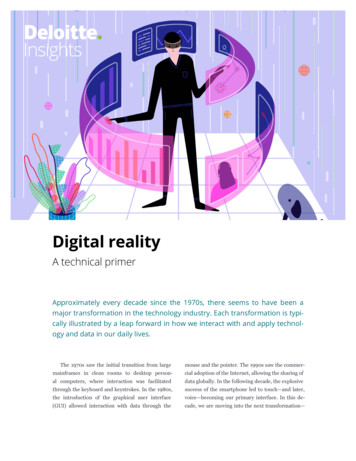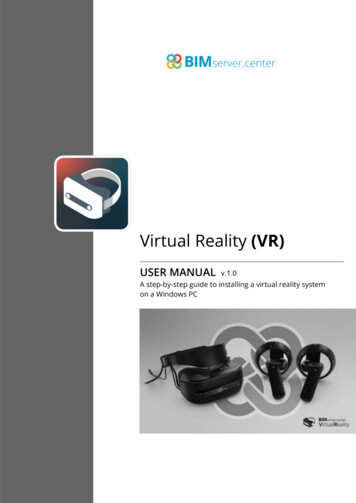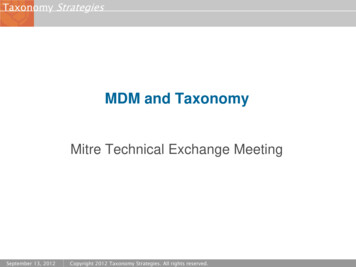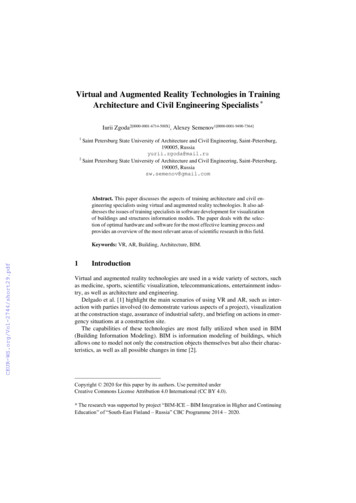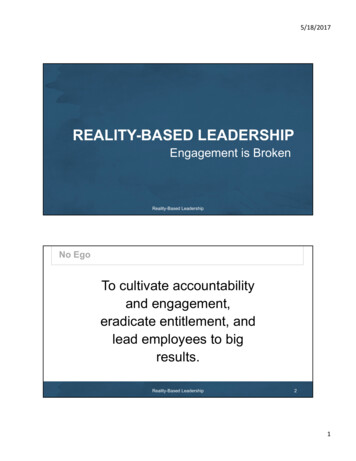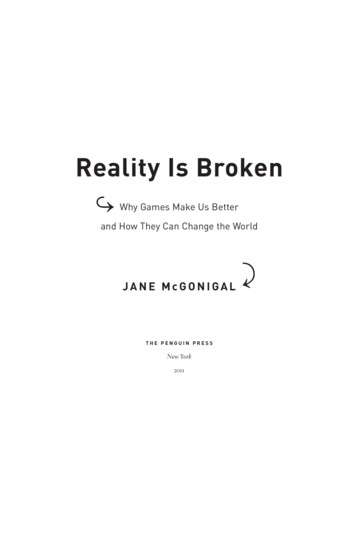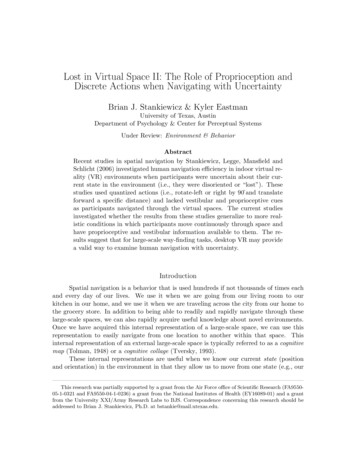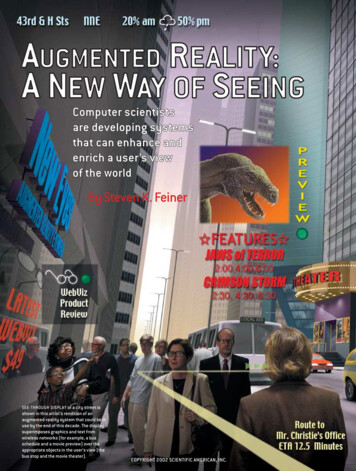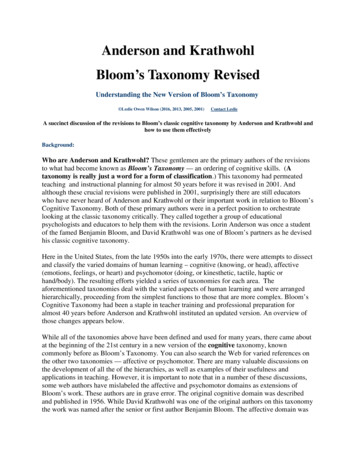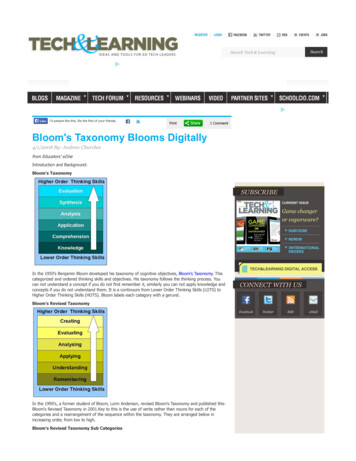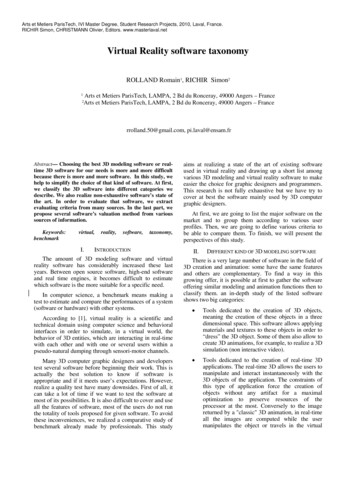
Transcription
Arts et Metiers ParisTech, IVI Master Degree, Student Research Projects, 2010, Laval, France.RICHIR Simon, CHRISTMANN Olivier, Editors. www.masterlaval.netVirtual Reality software taxonomyROLLAND Romain1, RICHIR Simon212Arts et Metiers ParisTech, LAMPA, 2 Bd du Ronceray, 49000 Angers – FranceArts et Metiers ParisTech, LAMPA, 2 Bd du Ronceray, 49000 Angers – Francerrolland.50@gmail.com, pi.laval@ensam.frAbstract— Choosing the best 3D modeling software or realtime 3D software for our needs is more and more difficultbecause there is more and more software. In this study, wehelp to simplify the choice of that kind of software. At first,we classify the 3D software into different categories wedescribe. We also realize non-exhaustive software’s state ofthe art. In order to evaluate that software, we extractevaluating criteria from many sources. In the last part, wepropose several software’s valuation method from varioussources of ftware,taxonomy,INTRODUCTIONThe amount of 3D modeling software and virtualreality software has considerably increased these lastyears. Between open source software, high-end softwareand real time engines, it becomes difficult to estimatewhich software is the more suitable for a specific need.In computer science, a benchmark means making atest to estimate and compare the performances of a system(software or hardware) with other systems.aims at realizing a state of the art of existing softwareused in virtual reality and drawing up a short list amongvarious 3D modeling and virtual reality software to makeeasier the choice for graphic designers and programmers.This research is not fully exhaustive but we have try tocover at best the software mainly used by 3D computergraphic designers.At first, we are going to list the major software on themarket and to group them according to various userprofiles. Then, we are going to define various criteria tobe able to compare them. To finish, we will present theperspectives of this study.II.There is a very large number of software in the field of3D creation and animation: some have the same featuresand others are complementary. To find a way in thisgrowing offer, it is possible at first to gather the softwareoffering similar modeling and animation functions then toclassify them. an in-depth study of the listed softwareshows two big categories: Tools dedicated to the creation of 3D objects,meaning the creation of these objects in a threedimensional space. This software allows applyingmaterials and textures to these objects in order to“dress” the 3D object. Some of them also allow tocreate 3D animations, for example, to realize a 3Dsimulation (non interactive video). Tools dedicated to the creation of real-time 3Dapplications. The real-time 3D allows the users tomanipulate and interact instantaneously with the3D objects of the application. The constraints ofthis type of application force the creation ofobjects without any artifact for a maximaloptimization to preserve resources of theprocessor at the most. Conversely to the imagereturned by a "classic" 3D animation, in real-timeall the images are computed while the usermanipulates the object or travels in the virtualAccording to [1], virtual reality is a scientific andtechnical domain using computer science and behavioralinterfaces in order to simulate, in a virtual world, thebehavior of 3D entities, which are interacting in real-timewith each other and with one or several users within apseudo-natural dumping through sensori-motor channels.Many 3D computer graphic designers and developerstest several software before beginning their work. This isactually the best solution to know if software isappropriate and if it meets user’s expectations. However,realize a quality test have many downsides. First of all, itcan take a lot of time if we want to test the software atmost of its possibilities. It is also difficult to cover and useall the features of software, most of the users do not runthe totality of tools proposed for given software. To avoidthese inconveniences, we realized a comparative study ofbenchmark already made by professionals. This studyDIFFERENT KIND OF 3D MODELING SOFTWARE
ROLLAND Romain & al., Virtual Reality software taxonomyArts et Metiers ParisTech, IVI Master Degree, Student Research Projects, 2010, Laval, France.environment. We can speak about virtual realitywhen we simulate the behavior of objects in avirtual world. Most of real-time 3D applicationsare potentially virtual reality applications.The complete list of software is presented at the end ofthis paper.We will now describe more precisely the two bigcategories of software.A. 3D modeling softwareAs mentioned before, all 3D modeling tools do notperform all the same functions, so it would be interestingto categorize these software. To realize this classification,we were inspired by several lists of 3D software oninternet, and more particularly by the work of BenoîtRogez, who realized on its personal website a heuristicmap of the various software related to 3D 1 . His workcategorizes 3D software in 14 different categories whichcontain themselves several subcategories. We selectedapplications which seemed the most useful for theanalysis and chose to classify that software according to 6categories:1) General modeling softwareThis kind of software allows creating 3D objects. 3Dmodeling software is based essentially on themanipulation of primitive objects. These can be in 3D(cubes, spheres, cones), but also in 2D (rectangles, Béziercurves, NURBS). The software proposes a set of toolswhich allows transforming primitives objects to morecomplex objects like buildings or characters. This kind ofsoftware can also modify other attributes such as textureof the object, its lighting or its transparency. This softwaredoes not contain tools for performing animations and arenot really visible among "all in one" solutions, whichcontain tools for animation and other features. Among thatsoftware, we can name Hexagon made by DAZ 3D,AC3D from Inivis and Wings 3D.2) CAD softwareCAD software (Computer-Aided Design) allows toconceive complex systems, like cars or buildings and tovisually and technically estimate the system, in the closestconditions to physical reality. This software includes toolsto assist the engineer in the conception of a product. It isthe first step to realize mechanical parts or industrialsystems. We list in this category all architectural tools(architecture of buildings) such as SketchUp made byGoogle or Revit Architecture from Autodesk and designand engineering tools such as Solidworks made byDassault Systèmes or Autocad from Autodesk. We alsolist Product Lifecycle Management software. The PLMconsists of an optimal Information Technologymanagement of all the stages of the product’s life, sincethe expression of the need, up to the withdrawal from themarket [2]. We can name software like CATIA fromDassault Systèmes, NX from Siemens and alsoProENGINNER made by PTC.3) Digital sculpting softwareDigital sculpting or organic modeling software aredifferent from classic modeling software. Indeed, low "sculpting" a 3D object in real time. This techniqueallows an intuitive and a direct modeling, as if the userworks with modeling clay or wax [3]. This method ofwork has become more and more common to finalize ordetail a 3D object, in particular for characters andcreatures. This kind of software has two distinctivefeatures: on the one hand, it is able to calculate and showa huge number of polygons at the same time withoutslowing down the computer. On the other hand, once themodel’s editing ended, the user will often produce one"normal map" applied to the low resolution 3D object.This technique will give a relief illusion similar to thehigh resolution 3D object, keeping a reduced number ofpolygons. software the most considered in this domain areZbrush from Pixologic and Mudbox from Autodesk.There are also Silo made by Nervercenter, Argile from NSided, 3D Coat from 3D Brush and CB Model Pro madeby Dassault Systèmes.4) Humans and creatures authoring softwareThat kind of software allows creating quicklycharacters, animals and creatures in a different level ofquality. These models are easily editable, exportable anduser can change their poses thanks to dedicated tools.Then they can be exported towards other software toanimate them, to integrate them into a virtual environmentor also to edit them. The three mainly used solutions arePoser from SmithMicro, Quindam from N-Sided andDAZ studio made by 3D DAZ. There are alsoMakeHuman, an open source software from MakeHumanTeam and FaceGen Modeller from Singular Inversions Inc(this last one is specialized in faces creation).5) Landscapes and vegetation creation softwareThis kind of software is specialized on 3D overview. Itallows creating 3D landscapes and vegetation. Artificialterrains generated by the application are created through amix of procedural methods and user painting of heightfields [4]. The procedural methods, usually based onfractal subdivision, are controlled by user specifiedparameters. Erosion processes can be simulated on thesesurfaces [5]. It is also possible to import 3D objectsrealized in other software. We can name Vue d’Espritfrom E-on Software, 3D Bryce from DAZ 3D,WorldBuilder made by Digital Element and Terragenfrom Planetside.6) “all in one” softwareThese software are complete 3D solutions. They coverthe complete creation process of cartoon movies or 3Dcontents for video games, within a single software. Thissoftware contains, at least, tools for the modeling,animation, lighting, texturing, render and special effects.Some of them also allow managing physics, fabric, hairand fur materials as well as animation of fluids. Some ofthem can also animate 3D characters (physical and facialfeatures). This kind of software is widely developed andused. Among the reference software, it is important toname 3D Studio Max, Maya and Softimage (XSI) fromAutodesk, 3D Lightwave from NewTech, Cinema 4Dfrom Maxon, Carrara made by DAZ 3D, Houdini fromSide Effects and Blender, an open source software fromBlender foundation.
ROLLAND Romain & al., Virtual Reality software taxonomyArts et Metiers ParisTech, IVI Master Degree, Student Research Projects, 2010, Laval, France.B. Virtual Reality softwareAccording to [6], virtual reality software has tocontain 3 modules, which are: The render, which consists in transforminginformation of the virtual environment into areadable image by displays. The interaction with the virtual world. The simulation, which defines the behavior andthe evolution of a virtual reality application.A virtual reality software may run infinitely, or at leastuntil the user decides to stop it. This is called a loop. Inorder to produce an interaction with the user, virtualreality software contains 3 stages repeated in the loop ofthe program: Capture of the user’s actions Processing of the action by a simulation engineand output of an adequate answer. Broadcast of the answer towards the user.Those stages and the loop can also be applied to anyreal-time 3D application like 3D game engines andrendering engines. We choose to include 3D game engineand rendering engines in the virtual reality software classbecause they can be potentially used as virtual realitysoftware. In [7], Michael Zyda said that Virtual Reality field istransitioning into work influenced by video games andthus now influences that industry as well. Because muchof the research and development being conducted in thegames community parallels the Virtual Realitycommunity’s efforts, it has the potential to affect a greateraudience.However, we can distinguish two trends in this kind ofsoftware. On one hand, we have software initially createdfor video game, and on the other hand, we have softwarecreated for industrial and scientific domains using virtualreality devices: 1) Real time 3D game engines and rendering enginesAccording to [8], a 3D game engine should providethese features: Its outputs are graphic, music and sound effectsand its input is the input device. It provides the algorithm to make the charactermove. It controls the various topographies and plays therole of artificial intelligence It supports the network and monitors a lot ofthings in the network.In order to complete these roles, a 3D game engine iscomposed of different sub-engines. The rendering enginedisplays the object on the screen. The animation engineanimates it in real time and expresses the object’s motion.The physical engine deals with the object’s gravity,weight and collision. The artificial intelligence enginecontrols the characters which are not controlled by users.The network engine makes each user sharing the samevirtual space in order to interact each other. The 3D soundengine generates the game sound data to the gameprogress state. The map editor manages the 3D virtualenvironment like building, topography and characters [6].Game engines are designed with a component-basedarchitecture that allows specific systems in the engine tobe replaced or extended with more specializedcomponents. Despite the specificity of the name, gameengines are often used for other kinds of interactiveapplications with real-time graphical requirements such asmarketing demos, architectural visualizations and trainingsimulations [9].So, 3D game engines can be an economic alternativeto software that are really dedicated to virtual reality andprovide virtual reality features. A good example of virtualreality application using a 3D game engine is CaveUT[10]. It is an Open source project which uses the UnrealEngine, which is the game engine used for UnrealTournament (Epic Game). This project preserves theengine's built-in advantages, allows the re-use of existinggame content, and allows the creation of new contentusing standard methods. CaveUT, which follows theprinciples described in the original CAVE system,supports a variety of immersive display strategies, fromlow-tech to fully stereoscopic multiscreen display.Among the most considered game engines , we cancite the Unreal Engine 3 made by Epic Games, Unity 3Dfrom Unity Technologies, and Torque 3D from GarageGames.In this category, we also choose to include real timerender engines. They do not allow creating completeapplications but have the main role of 3D game engine.The goal is to display the information made by graphicdesigners to the game state in real time on the screen.However, it is possible to add extensions (like physicalengine, AI engine or sound engine) which allow to createa custom 3D game engine. Among these render engines,we can cite Ogre 3D developed by Torus Knot Software,Crystal Space from Crystal Space Team and Open SceneGraph.2) Virtual Reality softwareVirtual Reality software can be similar to 3D gameengines, however, it contains additional tools dedicated tointegration and management of virtual reality devices suchas head mounted devices, professional haptic devices,workbenches or CAVE systems. Most current virtualreality environments provide primarily visual experiences,displayed either on a computer screen or through specialor stereoscopic displays, but some simulations includeadditional sensory information, such as sound. Someadvanced haptic systems now include tactile information,generally known as force feedback, in medical andgaming applications. Users can interact with a virtualenvironment or a virtual artifact either through the use ofstandard input devices such as a keyboard and mouse, orthrough multimodal devices [11] as previously cited. Themarket of multi-interfaces virtual reality software remainsrather limited, quality platforms are expensive and someresearch laboratories prefer to develop their ownapplications. Among the most known, we can cite 3D Via
ROLLAND Romain & al., Virtual Reality software taxonomyArts et Metiers ParisTech, IVI Master Degree, Student Research Projects, 2010, Laval, France.Virtools from Dassault Systèmes, Vizard made byWorldVIZ, 3D Quest from Act-3D, Eon Reality Studiofrom Eon Reality, TechViz XL made by TechViz, someOpen Source software like OpenMask from the InstitutNational de Recherche en Informatique et Automatique(INRIA) , and VR Juggler from the Iowa State UniversityVRAC.III.HOW TO EVALUATESOFTWARERealizing a software benchmark is a complex task: itis necessary to get a version and a license of the softwareand a benchmarking tool; besides, it asks for a rigoroustesting methodology, which takes a lot of time. So wechoose to make use of existing benchmarks, to aggregatetheir results by comparing them and to build our owngraphs and mappings.We will now choose evaluating criteria and proposesome valuating method from comparison studies alreadymade by professionals.A. Choice of evaluating criteriaTo realize our benchmark we have to establish acriteria comparison list. Naturally, each software does nothave the same main features and users have not the sameexpectations. According to the kind of software, there willnot be the same dominating criteria. However, we can findsome common criteria among all this software.T-o find objective criteria, we based our work onvarious software evaluation websites such ashttp://www.devmaster.net, which lists existing 3D enginesor Benoît Saint-Moulin's article appeared on his website[12], who established a comparison table of 3D software.We also search on studies like “A mapping game enginesfor visualization” made by David Birch[13]. We extracttwo kinds of criteria, that are general and specific criteria.1) General criteriaThose criteria can be applied to each software, notnecessary 3D modeling or virtual reality software. Thesefirst criteria were elicited in [12] : The software’s first targeted market (engineering,video games, cinema ) The cost of licence/subscription and the annualsubscription The compatibility with operating(Windows, Mac, Linux) and consoles The industry usage of the software (never orusually used in the first target market) The learning path to be productive, in months. The quality of company support for single user The quality of software’s documentation The compatibility with import/export needed byindustriessystems The number of base package for industries need The user communities and software’s popularityIn addition to this first set of criteria, we add thesecriteria: The software general stability The frequency of updates The ease of use which includes the training timeand the interface’s clarity The software’s after-sales services, like tutorials,community reactivity (can be compared tosoftware’s documentation and user communities ) The necessity to had a professional training inorder to use the software2) Specific criteriaTo realize a more accurate evaluation, we can also usecriteria which are more specific and which can be onlyapplied to a kind of software.a) 3D modeling softwareWe find some interesting criteria for 3D modelingsoftware in the CGSociety’s wiki [9]: The modeling tools features like NURBS,Polygon, Patch. The workable Polygon limit (in number ofpolygon) according to computer’s power. The supported file formats import/export (OBJ,3DS, DXF, VRML ) The animation and simulation features(characters, physics, cloth, hair, smoke.) The texturing and paintingunwrapping, vertex paint.)features(UVIn the Benoit Saint-Moulin’s article [12], we also findrelevant criteria including: The quality of the rendering engine and theplugins (scanline, mental ray, Vray.). The quality of each package (animation tools, UVtools, modifiers, cloths ) The scripting tools qualityb) Virtual reality softwareIn the David Birch’s study [13], which is acomparative study carried out between Oct 2009 &January 2010 into the scalability of game engines for usein the Built Environment Modeling community, weextract these criteria: The speed of development, or usability, in orderto gain good return of investment and to quicklyprototype new models. The customizability, meaning the ability for anengine environment to allow customization andmodification, enabling creation of novel andunique features required for a specific project.
ROLLAND Romain & al., Virtual Reality software taxonomyArts et Metiers ParisTech, IVI Master Degree, Student Research Projects, 2010, Laval, France. The visual fidelity, meaning that the enginesupports a high level of visual fidelity such thatmodels look realistic and the management ofadvanced lightning techniques.However, Blender’s training DVD’s are low quality.The training time is better for cinema 4D (less thanone month) and less than three months for Maya andWe use the website DevMaster.net [14], which is areference in Game and Graphics Engines Database. In thedifferent features for each game engine, we have reusedsome information like: The number and the quality of tools and built-ineditors The Artificial Intelligence features The lighting features and their quality The coding tools (pure coding, nodal or mixed) The special effects features and their quality(environment mapping, particle system, fire,smoke, weather )B. Valuation method proposalOnce criteria have been elicited, we can now proposesoftware’s evaluation. The ideal would have been toconsider all the software, however, the number ofsoftware being consequent. In a worry of clarity, wechoose to realize this test on a limited range of softwarefor each family.a) 3D modeling softwareWe choose to evaluate first "all in one" software. Wecompare the five most known software by the generalpublic on a scale from 0 (worst mark) to 5 (best mark),according to three criteria (figure 1). These graphs wereinspired by the work Benoit Saint-Moulin [12].The industry popularity shows us that Lightwave 3D,Maya and 3D Studio Max are the most used in industry.Blender is the less popular, in spite of his qualities,probably because it is open source and, at first sight,because of its an unfriendly interface. The after-salesservices contain company support and reactivity,documentations and training DVD’s. The graphic showsus that Lightwave 3D has very good after-sales servicesespecially with very complete documentations. Maya hasalso a complete documentation, with very good trainingDVD’s. Cinema 4D has excellent support reactivity but itstraining DVD’s are poor. 3D Studio Max has gooddocumentation and training DVD’s but its companysupport varies from poor to good. Blender is a special casebecause its support is the community with forums.Figure 1 Popularity in various domainsBlender.We realized a second graphic (Fig.2) on the popularityof this software in four main professional domains whichuse these tools: virtual reality, video games, design andcinema. We can see on this graphic that each software hasa main domain. Maya is better for cinema, Cinema 4D isclearly focused on design, Lightwave 3D is good forcinema. 3D Studio Max, the most well known and used, isvery good for real time, video games and design; Blenderis good for real time.In the Fig. 3 mapping, we can see tools qualityaccording to price of seven software used in 3D modeling.The tool quality of each software has been computed fromevaluation of each tool (animation, UV tools, hair, cloth,Particles) with a mark from 1 to 4 [12], and converted inpercentage for a better clarity. We can see in this mappingthat Softimage’s XSI is the best software according to hisprice. It is a very good software in animation, UV tools,modeling and compositing. Modo is an affordablesoftware which doesn’t have many tools but their qualityFigure 3 Prices versus tools qualityFigure 2 Comparison of “all in one” software
ROLLAND Romain & al., Virtual Reality software taxonomyArts et Metiers ParisTech, IVI Master Degree, Student Research Projects, 2010, Laval, France.is good, especially UV, sculpting and painting tools.Lightwave 3D is also an affordable software, with goodmodeling tools. Blender is the best open source 3Dsoftware, most of tools are powerfull (particularly UVtool) but less intuitive than others software. Maya has thebest quality tools, it is the most used software in cinemabecause it has first quality animation tools. Cinema 4Dhas very good tools in UV and painting. 3D Studio Max,the last, is the most known and also the more expensivesoftware of the mapping, it has very good quality toolsespecially modeling and modifiers.have, naturally, less features than game engines.b) Virtual Reality softwareTo help us evaluating Virtual Reality software, weused the David Birch’s work [13] and data fromDevMaster.net [14].The Fig.4 is a mapping of software’s featuresaccording to the interface. Features are shown inpercentage (100% mean the perfect engine which has allof features). This mapping aim helping to choose asoftware according to user needs and skills. To create anapplication with limited coding skills, it will be moreconvenient to choose a visual or mixed interface. For adeveloper, a pure coding interface will not be a problem.In this mapping, 3D Via Virtools and Quest 3D are on theside of visual interfaces, they both mainly use graphicalscripting for the creation of the whole application. Forsmall projects, it can considerably reduce developmenttime but in big projects, it can become very complex.Concerning mixed interfaces, Unreal Engine (UDK) andCryEngine 3 are the best engines, widely used in industryfor computer games. They have a large list of features andstrong performances and rendering qualities. All thesoftware, except Ogre and OpenSceneGraph areWYSIWYG editors (What You See Is What You Get)meaning 3D content displayed during editing appears verysimilar to the final output. Unity, Torque Engine andShiva 3D are medium size game engines. They allowcross platform development and web publishing. Ogre andOpenScenGraph are powerfull render engines but theyFigure 4 Features according to the interfaceFigure 5 First targeted marketIn Fig.5, we can see the first targeted market for eachsoftware. Unreal Engine, CryEngine 3 and Source engineare mainly used by video game’s industry. Ogre 3D and3D game engines like Blender Game engine, Unity 3D,Torque Game engine, Panda 3D, Shiva 3D and DX Studioare mainly used in games and however, can be used todevelop real time applications. Vizard, Eon reality and theopen source software Open Mask are used for immersiveand non-immersive virtual reality applications. Quest 3D,initially used for architectural visualization and 3D ViaVirtools, initially used for video games, can work in thethree markets but they also very used to create virtualreality applications. OpenSceneGraph is an open sourcerender engine used for real time application and virtualreality. In this mapping, we can notice that there is nosoftware dedicated to generic real time applications, mostof software are centered on video games or virtual reality,because they are the biggest markets.Figure 6 Visual fidelity according to price
ROLLAND Romain & al., Virtual Reality software taxonomyArts et Metiers ParisTech, IVI Master Degree, Student Research Projects, 2010, Laval, France.The Fig.6 shows us a mapping of visual fidelity versusthe price of software (for the less expensive professionallicense). The visual fidelity is, according to David Birch, anormalized estimation of the visual fidelity orphotorealism which the engine can achieve [13]. In thismapping, Ogre 3D and OpenSceneGraph are free. Thevisual fidelity of Ogre3D is better than OpenSceneGraphbecause this last one has a lack of a current editor andadvanced lightning techniques. Unity 3D, Torque 3D andShiva 3D have very similar visual fidelity with advancedrendering systems, but Unity 3D seems to be the bestcompromise according to the price. Pro version of Unityis 880 (Free for non commercial use), Shiva editorAdvanced version is 1 199 and Torque 3D individual Prolicense is 1000. Unreal Engine SDK provide a noncommercial free version and a commercial version at 99or 2 500 with a percentage of royalties over 5,000 ofrevenue. CryEngine has also a very good visual fidelitybut the license price is unknown. 3D Via Virtools isaround to 10 000, and has an average visual fidelity.Quest 3D has a good visual fidelity, especially foradvanced lightning. The creative edition of Quest3D is at 1249 and the VR edition (with virtual reality devicesmanagement) at 9999.continue this work, it will also be interesting to create anonline database, like DevMaster.net, with a list ofsoftware used for Virtual reality (beginning with our list)where anybody could give a mark to software he ION AND DISCUSSIONIn this study which aims to simplify the choice ofvirtual reality or 3D modeling software, we realized atfirst a non exhaustive software’s state of the art. Then, werealized a classification of the software offer. Then, weextracted a list of criteria from various sources with theaim of estimating this software.In this paper, we have realized mappings andcomparative study from various sources of information. Itresult from a probability of imprecision, therefore, themost important in this paper is the software evaluationmethodology. We had no resources and time to do thesoftware’s tests ourselves, but it will be interesting tocarry on our work and realize the tests in order to havemore accurate results.On the other hand, we chose to realize a categorizationcontaining two kinds of software for virtual reality. Itwould also be interesting to add into the classificationothers kind of software’s like collaborative virtualenvironments platforms. According to Wikipedia,collaborative virtual environment are used forcollaboration and interaction of possibly manyparticipants that may be spread over large distances.Typical examples are distributed simulations, 3Dmultiplayer games, collaborative engineering software To create collaborative virtual environments, we can usesoftware such as Forterra’s On-Line Interactive VirtualEnvironm
real-time 3D application like 3D game engines and rendering engines. We choose to include 3D game engine and rendering engines in the virtual reality software class because they can be potentially used as virtual reality software. In [7], Michael Zyda said that Virtual Reality field is transitioning into work influenced by video games and
